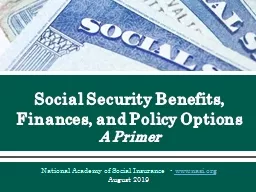PPT-Social Security Benefits, Finances, and Policy Options
Author : sequest | Published Date : 2020-10-01
A Primer National Academy of Social Insurance wwwnasiorg August 2019 What is Social Security How Many People Receive Social Security More than 66 million
Presentation Embed Code
Download Presentation
Download Presentation The PPT/PDF document "Social Security Benefits, Finances, and ..." is the property of its rightful owner. Permission is granted to download and print the materials on this website for personal, non-commercial use only, and to display it on your personal computer provided you do not modify the materials and that you retain all copyright notices contained in the materials. By downloading content from our website, you accept the terms of this agreement.
Social Security Benefits, Finances, and Policy Options: Transcript
Download Rules Of Document
"Social Security Benefits, Finances, and Policy Options"The content belongs to its owner. You may download and print it for personal use, without modification, and keep all copyright notices. By downloading, you agree to these terms.
Related Documents














